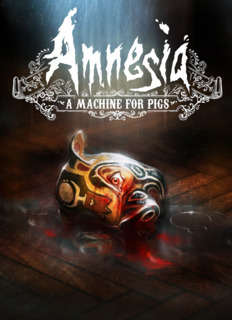A combination that is less than the sum of its parts.
Amnesia: The Dark Descent was a breakout hit for Frictional games, but it was not their first horror experience. The Penumbra series, while rougher around the edges, included an abundance of fear, puzzles and interaction. If there was one particular weakness in all of their games, it would be the crude presentation. Forgivable though, because of the tricks used to hide the fact that the games were made primarily by two people. Dear Esther is essentially a story experience, which is as cryptic as it is beautiful. It made sense for The Chinese Room build on Amnesia and craft a richer visual experience. These presentation improvements come at a cost though.
True to the original, the game begins with the player awaking in a mansion with no idea of what is going on. It is here they start to unravel the mystery behind machines, pigs and weird looking children. Children appear in the hallways of this lavish mansion, and they beckon the player towards them. This leads you into the streets, through a church and then deep underground. All you know is that you must follow these children and save them from future horrors.
There are noticeable presentation changes compared to Dark Descent. The new developers have brought a flair for environmental detail. Many of the locations are well presented and carefully proportioned. Scripted scares are delightfully soul-destroying, although many are still crude because of the primitive animations. The exposition quality has lifted, dialogue is particularly mysterious and journal notes are well written. You will come across gramophones and telephones which release suitably voiced recordings that help you fit the pieces together. During normal progress, you hear voices that flow like Dear Esther and not just because it uses the same voice actor. A Machine for Pigs starts to fall down when it turns towards the gameplay elements.
Puzzles, a core gameplay component, are disappointing because they require little thought and minimal exploration. Gear wheels are placed near broken machines, requiring you to merely pick them up lock them in place. Coal pieces are found near furnaces, requiring you to simply drop them inside. One chemical needs to be mixed, but it cannot be mixed incorrectly and you are given obvious directions. Valves and switches can be turned, but you won't need to think about why and will not get it wrong. The puzzles are so shallow that they might as well not exist in the world. Puzzles were important in Dark Descent, but here they are little more than an afterthought.
Interaction with the game world is also limited. Doors and valves operate as they did before – you physically move the mouse to open them. Some lights can be switched on, although the lack of shadows is disappointing. When it comes to the rest of the world, everything is static. The only objects not glued down are those required for basic puzzles. You will probably be smart enough to grab unconstrained items in order to solve puzzles faster than the developers anticipated. Given the proficient physics engine, it is criminal that I can only remember pushing a cylinder two feet to solve a physics puzzle. The systematic neutering of puzzles, and interactive elements, is the biggest let-down.
Alterations to pacing further depreciate the aspects found in Dark Descent. Unlike the original, lanterns have infinite oil reserves and there are no tinder boxes. Therefore, you will not need to conserve oil or light torches to guide you through well-travelled areas. Removing both devices is no mere coincidence, as you spend little time in the each area before moving on. The lantern light also replaces the sanity effect from Dark Descent. When enemies are near, the lantern begins flickering. Looking directly at monsters produces fast light pulses and dims the lantern. Although this emulates sanity on the surface, it forgets that turning away elevates tension. Possessed by the creators of Morse code, this new lantern is no match for the reliable, oil-fuelled version found in Dark Descent.
The game teaches you one important lesson about fear: You can run away from your problems. Running has no downside, as you don't run out of stamina and there are no fast creatures. Trying to hide during the first two encounters just led to my death. If you see a pig creature patrolling a hallway, run past him. If you see another blocking progress, draw it to one side of crates and run around. If a scripted monster spawns from behind, well, you already know what to do. There is even a sequence near the end of the game that forces you through a linear warzone and you better believe you'll be running. Being able to run away from anything is a problem. If the player knows they can avoid death by running around like a headless chicken, why would they be afraid of mutated swine?
Amnesia: A Machine for Pigs is more of a game than Dear Esther, but it is less of a game than Dark Descent. This places it into a weird zone that may alienate fans of both games. It clearly panders towards the Amnesia fan base, with shallow remnants of puzzles and interaction. But this little more than patting a stray dog before it is euthanized. If you found the puzzles laborious in Amnesia, then this simplified version might be more your style. As somebody who enjoyed both Dear Esther and the original Amnesia, it is strange to be disappointed by this anomalous combination. A Machine for Pigs carries the Amnesia name, therefore it is impossible to ignore the differences. Comparing them leads you down a dark path of inadequacies that cannot be washed away by scares or improved presentation.

